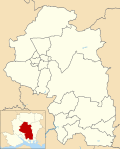| Upham | |
|---|---|
 Southeastern corner of Upham triangle | |
Location within Hampshire | |
| Population | 616 [1] 663 (2011 Census) [2] |
| OS grid reference | SU531202 |
| Civil parish |
|
| District | |
| Shire county | |
| Region | |
| Country | England |
| Sovereign state | United Kingdom |
| Post town | Southampton |
| Postcode district | SO32 |
| Dialling code | 01489 |
| Police | Hampshire and Isle of Wight |
| Fire | Hampshire and Isle of Wight |
| Ambulance | South Central |
| UK Parliament | |
| Website | Upham Parish Council |
Upham is a small village and civil parish in the south of England located in Hampshire approximately 7 miles south-east of Winchester .



